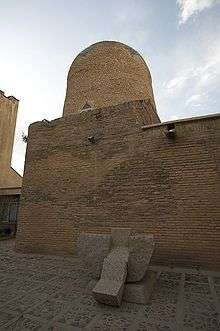Esther
Esther[lower-alpha 1] is described in all versions[lower-alpha 2] of the Book of Esther as the Jewish queen of a Persian king Ahasuerus.[1] In the narrative, Ahasuerus seeks a new wife after his queen, Vashti, refuses to obey him, and Esther is chosen for her beauty. The king's chief adviser, Haman, is offended by Esther's cousin and guardian, Mordecai, and gets permission from the king to have all the Jews in the kingdom killed. Esther foils the plan, and wins permission from the king for the Jews to kill their enemies, and they do so. Her story provides a traditional background for Purim, which is celebrated on the date given in the story for when Haman's order was to go into effect, which is the same day that the Jews killed their enemies after the plan was reversed.
| Esther | |
|---|---|
| Biblical Queen of Persia | |
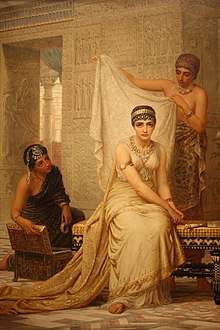 Queen Esther (1879) by Edwin Long | |
| Predecessor | Vashti |
| Born | Hadassah Achaemenid Empire |
| Spouse | Ahasuerus |
| Father | Abihail (biological) Mordecai (adoptive) |
| Religion | Judaism |
Etymology
It was a common Jewish practice in antiquity, attested especially in the Book of Daniel (1:7) and I Maccabees (2:2-5), to have not only a Hebrew name but also one redolent of pagan connotations.[2] In the Tanakh Esther is given two names: Hadassah/Esther (2:7). Various hypotheses vie for the etymology of the latter. Hebrew hadassah is the feminine form of the word for myrtle,[3][lower-alpha 3] a plant that has a resonance with the idea of hope.[lower-alpha 4]
Early rabbinical views varied. According to the Bavli (Megillah 13a), Rabbi Nehemiah thought her second name was a heteronym used by Gentiles, based on אסתהר ( 'īstəhăr), the morning star Venus,[4] an association preserved by Yalkut Shimoni (1053:7) and in Targum Sheni. Conversely, Rabbi Jehoshua maintained that Esther was her original name, and that she was called Hadassah (myrtle) in Hebrew because she had an (olive-)green complexion.[5] In modern times, the view of the German Assyriologist Peter Jensen that the theonym for the Babylonian goddess Ishtar lay behind Esther gained a general consensus. He also thought that the Hebrew name was to be linked to an Akkadian word meaning 'bride' (ḫadašatu) which happens to be an epithet often attached to the Babylonian goddess. His other speculation, that ḫadašatu itself also meant myrtle, has no empirical basis in Akkadian texts.[6][lower-alpha 5]
Abraham Yahuda conjectured in 1946 that, particularly in light of the Persian setting, the first syllable of 'Esther' (es-) must reflect the Persian word for myrtle, ās (سآ)), and therefore her name was the Persian equivalent of "Hadassah" with both meaning myrtle. This required him to hypothesize that behind ās lay an earlier old Iranian word, *aça (as(s)a) meaning 'myrtle', which would be reproduced in a conjectural Medic form *astra, preserved in the Hebrew name רתסא.[7][8] His premise assumed that the Semitic word was a loanword from old Persian, a highly improbable assumption since the Semitic word is attested long before contact with Persian-speakers.[9][lower-alpha 6]
In 1986 Ran Zadok dismissed the etymological correlation between Babylonian Ishtar and Esther on two grounds. One regards the principles governing phonological shifts in Semitic loadwords. The Hebrew form 'str in Esther cannot represent Akkadian Ištar for neo-Akkadian borrowings into Aramaic conserve the original š rather than altering it to 's', as would be the case here were the two linked. Secondly, Ishtar is a theonym, never an anthroponym unless modified significantly.[10][lower-alpha 7] Zadok then ventured an alternative derivation, suggesting that the only plausible etymology would be from the Old Iranian word for 'star' (ستاره (setāre)), usually transcribed as stara, cognate with Greek ἀστήρ (astér as in 'astronomy'),[lower-alpha 8] the word Hellenistic Jews used to interprete her name.[11][12]
David Testen advanced in 1996 a simpler solution than Yasuda's, by suggesting that as a name 'ester' could be a compound term conflating Semitic ās with the Old Iranian term for a tree ( dā́ru./drau-) to yield 'myrtle tree').[9]
In the Bible
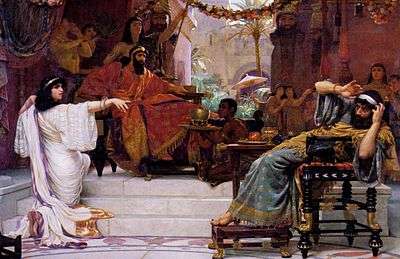
In the narrative, King Ahasuerus is drunk at a celebration of the third year of his reign, and orders his queen, Vashti, to appear before him and his guests in the nude to display her beauty. When she refuses to appear, he has her banished and seeks a new queen. Beautiful maidens gather together at the harem in the citadel of Susa under the authority of the eunuch Hegai.[13]
Esther, cousin of Mordecai, was a member of the Jewish community in the Exilic Period who claimed as an ancestor Kish, a Benjamite who had been taken from Jerusalem into captivity. She was the orphaned daughter of Mordecai's uncle, another Benjamite named Abihail. Upon the king's orders Esther is taken to the palace where Hegai prepares her to meet the king. Even as she advances to the highest position of the harem, perfumed with myrrh and allocated certain foods and servants, she is under strict instructions from Mordecai, who meets with her each day, to conceal her Jewish origins. The king falls in love with her and makes her his Queen.[13]
Following Esther's coronation, Mordecai learns of an assassination plot by Bigthan and Teresh to kill King Ahasuerus. Mordecai tells Esther, who tells the king in the name of Mordecai, and he is saved. This act of great service to the king is recorded in the Annals of the Kingdom.
After Mordecai saves the king's life, Haman the Agagite is made Ahasuerus' highest adviser, and orders that everyone bow down to him. When Mordecai (who had stationed himself in the street to advise Esther) refuses to bow to him, Haman pays King Ahasuerus 10,000 Silver Talents for the right to exterminate all of the Jews in Ahasuerus' kingdom. Haman casts lots, Purim, using supernatural means, and sees that the thirteenth day of the Month of Adar is a fortuitous day for the genocide. Using the seal of the king, in the name of the king, Haman sends an order to the provinces of the kingdom to allow the extermination of the Jews on the thirteenth of Adar. When Mordecai learns of this, he tells Esther to reveal to the king that she is Jewish and ask that he repeal the order. Esther hesitates, saying that she could be put to death if she goes to the king without being summoned; nevertheless, Mordecai urges her to try. Esther asks that the entire Jewish community fast and pray for three days before she goes to see the king; Mordecai agrees.
On the third day, Esther goes to the courtyard in front of the king's palace, and she is welcomed by the king, who stretches out his sceptre for her to touch, and offers her anything she wants "up to half of the kingdom". Esther invites the king and Haman to a banquet she has prepared for the next day. She tells the king she will reveal her request at the banquet. During the banquet, the king repeats his offer again, whereupon Esther invites both the king and Haman to a banquet she is making on the following day as well.
Seeing that he is in favor with the king and queen, Haman takes counsel from his wife and friends to build a gallows upon which to hang Mordecai; as he is in their good favours, he believes he will be granted his wish to hang Mordecai the very next day. After building the gallows, Haman goes to the palace in the middle of the night to wait for the earliest moment he can see the king.
That evening, the king, unable to sleep, asks that the Annals of the Kingdom be read to him so that he will become drowsy. The book miraculously opens to the page telling of Mordecai's great service, and the king asks if he had already received a reward. When his attendants answer in the negative, Ahasuerus is suddenly distracted, and demands to know who standing in the palace courtyard in the middle of the night. The attendants answer that it is Haman. Ahasuerus invites Haman into his room. Haman, instead of requesting that Mordecai be hanged, is ordered to take Mordecai through the streets of the capital on the Royal Horse wearing the Royal Robes. Haman is also instructed to yell, "This is what shall be done to the man whom the king wishes to honour!"
After spending the entire day honoring Mordecai, Haman rushes to Esther's second banquet, where Ahasuerus is already waiting. Ahasuerus repeats his offer to Esther of anything "up to half of the kingdom". Esther tells Ahasuerus that while she appreciates the offer, she must put before him a more basic issue: she explains that there is a person plotting to kill her and her entire people, and that this person's intentions are to harm the king and the kingdom. When Ahasuerus asks who this person is, Esther points to Haman and names him. Upon hearing this, an enraged Ahasuerus goes out to the garden to calm down and consider the situation.
While Ahasuerus is in the garden, Haman throws himself at Esther's feet asking for mercy. Upon returning from the garden, the king is further enraged. As it was the custom was to eat on reclining couches, it appears to the king as if Haman is attacking Esther. He orders Haman to be removed from his sight. While Haman is being led out, Harvona, a civil servant, tells the king that Haman had built a gallows for Mordecai, "who had saved the king's life". In response, the king says "Hang him (Haman) on it".
After Haman is put to death, Ahasuerus gives Haman's estate to Esther. Esther tells the king about Mordecai being her relative, and the king makes Mordecai his adviser. When Esther asks the king to revoke the order exterminating the Jews, the king is initially hesitant, saying that an order issued by the king cannot be repealed. Ahasuerus allows Esther and Mordecai to draft another order, with the seal of the king and in the name of the king, to allow the Jewish people to defend themselves and fight with their oppressors on the thirteenth day of Adar.
On the thirteenth day of Adar, the same day that Haman had set for them to be killed, the Jews defend themselves in all parts of the kingdom and rest on the fourteenth day of Adar. The fourteenth day of Adar is celebrated with the giving of charity, exchanging foodstuffs, and feasting. In Susa, the Jews of the capital were given another day to kill their oppressors; they rested and celebrated on the fifteenth day of Adar, again giving charity, exchanging foodstuffs, and feasting as well.[14]
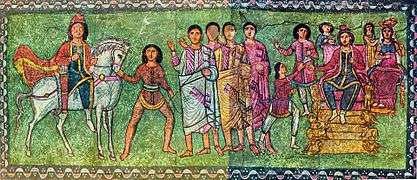
Purim
The Jews established an annual feast, the feast of Purim, in memory of their deliverance. Haman having set the date of the thirteenth of Adar to commence his campaign against the Jews, this determined the date of the festival of Purim.[15]
Historicity
Because the text lacks any references to known events, some historians believe that the narrative of Esther is fictional, and the name Ahasuerus is used to refer to a fictionalized Xerxes I, in order to provide an aetiology for Purim.[lower-alpha 9][lower-alpha 10][lower-alpha 11] Some historians additionally argue that, because the Persian kings did not marry outside a handful of Persian noble families, it is unlikely that there was a Jewish queen Esther and that in any case the historical Xerxes's queen was Amestris.[16][17][lower-alpha 12] That being said, many Jews believe the story to be a true historical event, especially Persian Jews who have a close relationship to Esther.[18]
Interpretations
Dianne Tidball argues that while Vashti is a "feminist icon", Esther is a post-feminist icon.[19]
Abraham Kuyper notes some "disagreeable aspects" to her character: that she should not have agreed to take Vashti's place, that she refrained from saving her nation until her own life was threatened, and that she carries out bloodthirsty vengeance.[20]
The tale opens with Esther as beautiful and obedient, but also a relatively passive figure. During the course of the story, she evolves into someone who takes a decisive role in her own future and that of her people.[21] According to Sidnie White Crawford, "Esther's position in a male court mirrors that of the Jews in a Gentile world, with the threat of danger ever present below the seemingly calm surface."[22] Esther is related to Daniel in that both represent a "type" for Jews living in Diaspora, and hoping to live a successful life in an alien environment.
Esther as rhetorical model
According to Susan Zaeske, by virtue of the fact that Esther used only rhetoric to convince the king to save her people, the story of Esther is a "rhetoric of exile and empowerment that, for millennia, has notably shaped the discourse of marginalized peoples such as Jews, women, and African Americans", persuading those who have power over them.[23]
Persian culture

Given the great historical link between Persian and Jewish history, modern day Persian Jews are called "Esther's Children". A building venerated as being the Tomb of Esther and Mordechai is located in Hamadan, Iran,[24] although the village of Kfar Bar'am in northern Israel also claims to be the burial place of Queen Esther.[25]
Depictions of Esther
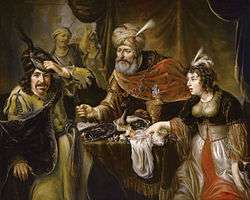
_-_Aert_de_GELDER_-_Google_Cultural_Institute.jpg)
There are several paintings depicting Esther. The Heilspiegel Altarpiece by Konrad Witz depicts Esther appearing before the king to beg mercy for the Jews, despite the punishment for appearing without being summoned being death.[13] Esther before Ahasuerus by Tintoretto (1546-47, Royal Collection) shows what became one of the most commonly depicted parts of the story. Esther's faint had not often been depicted in art before Tintoretto. It is shown in the series of cassone scenes of the Life of Esther attributed variously to Sandro Botticelli and Filippino Lippi from the 1470s. In other cassone depictions, for example by Filippino Lippi, Esther's readiness to show herself before the court is contrasted to Vashti's refusal to expose herself to the public assembly.[26][27]
Esther was regarded in Catholic theology as a typological forerunner[28] of the Virgin Mary in her role as intercessor[29] Her regal election parallels Mary's Assumption and as she becomes queen of Persia, Mary becomes queen of heaven; Mary's epithet as 'stella maris' parallels Esther as a 'star' and both figure as sponsors of the humble before the powerful,[30] because Esther being allowed an exception to the strict Persian law on uninvited entry to the king's presence was seen as paralleling the unique Immaculate Conception of Mary.
Contemporary viewers would probably have recognized a similarity between the faint and the motif of the Swoon of the Virgin, which was very common in depictions of the Crucifixion of Jesus.[31] The fainting became a much more popular subject in the Baroque painting of the following century, with examples including the Esther before Ahasuerus by Artemisia Gentileschi.[32]
Canonicity in Christianity
There are mixed views about the status of Esther as a canonical book in early Jewish and Christian tradition. The inclusion of the work in the Septuagint suggests that it was so among Greek-speaking Jews in the diaspora. That Esther shares bed and board with a gentile king, and the book itself makes no mention of God may have contributed to early Jewish doubts about its canonicity. The Mishnah mentions that it was read in synagogues during Purim (Megillah 1.1), and this liturgical custom perhaps accounts for its definitive acceptance in the Masoretic recension.[17]
Christian references to the book are rare in the writings of the Eastern Church Fathers, and had only marginal importance for several centuries in that tradition.[33] Esther does not appear in the lists of titles defining the canon produced by Melito, Athanasius, Cyril, Gregory of Nazianzus, and others. Additionally, no copies or fragments of Esther were found at Qumran in the contents of the Dead Sea Scrolls.[17][lower-alpha 13][34][35][36] It was accepted by Cyril of Jerusalem, and by the Synod of Laodicea (364-365 CE), and confirmed as such at Council of Rome (388) and the Synod of Hippo (393).[17] Subsequently, the Western church tradition generally followed the influential Augustine's lead in defining a much larger biblical corpus, which included Esther.[36]
Esther is commemorated as a matriarch in the Calendar of Saints of the Lutheran Church–Missouri Synod on May 24. She is also recognized as a saint in the Eastern Orthodox and Coptic Orthodox Churches. "The Septuagint edition of Esther contains six parts (totaling 107 verses) not found in the Hebrew Bible. Although these interpretations originally may have been composed in Hebrew, they survive only in Greek texts. Because the Hebrew Bible's version of Esther's story contains neither prayers nor even a single reference to God, Greek redactors apparently felt compelled to give the tale a more explicit religious orientation, alluding to "God" or the "Lord" fifty times."[37] These additions to Esther in the Apocrypha were added approximately in the second or first century BCE.[38][39]
The story of Esther is also made reference to in chapter 28 of 1 Meqabyan, a book considered canonical in the Ethiopian Orthodox Tewahedo Church.
Music
- Marc-Antoine Charpentier, Historia Esther, H 396, for soloist, chorus, strings and continuo, 1675.
- George Frideric Handel, Esther, with a libretto based on a play by Jean Racine, 1718 and 1732.
- Elisabeth Jacquet de la Guerre, Esther, for soprano and continuo, 1708.
Notes
- /ˈɛstər/; Hebrew: אֶסְתֵּר, romanized: 'Estēr), born Hadassah (Hebrew: הֲדַסָּה, Modern: Hadasa, Tiberian: Haḏasā.
- "The origin of the Book of esther is somewhat obscure, not least because the book exists in two distinct forms: a shorter version in Hebrew (as found in Jewish and Protestant Bibles) and a longer version in Greek (as found in Catholic and Orthodox Bibles)." (Hahn & Mitch 2019, p. 71)
- The biblical and Mishnaic masculine form is hặḏas. (Testen 1998, p. 281)
- For the association of myrtle with hope in the Bible see Nehemiah 8:14; Isaiah 55:13 (Phillips 2008, p. 188)
- ḫadašatu appears to be related etymologically to the verb ḫašādu ('to make love'). (Yahuda 1946, p. 175 n.1)
- Testen himself did not exclude the possible that the various semitic terms for myrtle came ultimately from a non-Semitic source, with a phonological shape *adss-. (Testen 1998, p. 288)
- Leith writes however that her name is 'cognate with Ishtar, the Mesopotamian goddess of love and war, whose name was used as a personal name in this period.' (Leith 2011, p. 252)
- According to John Huehnergard, the Proto-Semitic word for 'morning/evening star', namely the reconstructed form ∗ʕaθtar is one of several that bear a resemblance to Indo-European roots, in this case PIE ∗h2ste:r-. The significance of such similitaries remains obscure, (Huehnergard 2008, p. 243)
- "Today there is general agreement that it is essentially a work of fiction, the purpose of which was to justify the Jewish appropriation of an originally non-Jewish holiday. What is not generally agreed upon is the identity or nature of that non-Jewish festival which came to be appropriated by the Jews as Purim, and whose motifs are recapitulated in disguised form in Esther." (Polish 1999)
- "The story is fictitious and written to provide an account of the origin of the feast of Purim; the book contains no references to the known historical events of the reign of Xerxes." (Browning 2009)
- "Although the details of its setting are entirely plausible and the story may even have some basis in actual events, in terms of literary genre the book is not history." (Tucker 2004)
- "Xerxes could not have wed a Jewess because this was contrary to the practices of Persian monarchs who married only into one of the seven leading Persian families. History records that Xerxes was married to Amestris, not Vashti or Esther. There is no historical record of a personage known as Esther, or a queen called Vashti or a vizier Haman, or a high placed courtier Mordecai. Mordecai was said to have been among the exiles deported from Jerusalem by Nebuchadnezzar, but that deportation occurred 112 years before Xerxes became king." (Littman 1975a:146)
- Józef Tadeusz Milik argued however that some fragments found in 4Q were suggestive of an Aramaic story of Esther predating the Hebrew version. (Milik 1992, pp. 321–406)
Citations
- Littman 1975b, pp. 145,155 p.?.
- Macchi 2019.
- Yahuda 1946, p. 174.
- Koller 2014, p. 38,n.11.
- Yahuda 1946, p. 174, n.2.
- Yahuda 1946, pp. 174–175.
- Yahuda 1946, pp. 175–177.
- Meyers 2007, p. 324.
- Testen 1998, p. 281,n.2.
- Zadok 1986, p. 107.
- Zadok 1986, p. 107&n.17.
- Yamauchi & Phillips 2017, p. 249.
- Solle 2006, p. 107.
- Hirsch, Prince & Schechter 1936.
- Crawford, Sidnie White. "Esther: Bible", Jewish Women's Archive.
- Fox 2010, pp. 131–140.
- Hahn & Mitch 2019, p. 71.
- Saba Soomekh, From the Shahs to Los Angeles: Three Generations of Iranian Jewish Women between Religion and Culture, SUNY Press 2012 ISBN 978-1-438-44385-0p.38
- Tidball 2001.
- Kuyper 2010, pp. 175–76.
- Coogan et al. 2007.
- Crawford 2003.
- Zaeske 2000, p. 194.
- Vahidmanesh 2010.
- Schaalje 2001.
- Baskins 1995, p. 38.
- Wind 1940–1941, p. 114.
- Baskins 1995, p. 37.
- Bergsma & Pitre 2018.
- Baskins 1995, p. 40.
- Whitaker & Clayton 2007.
- Metropolitan Museum of Art.
- Miller 2015, p. 2.
- Crawford 1996, pp. 307–325.
- Silverstein 2014, p. 552.
- McDonald 2006, pp. 56,109,128,131.
- Harris & Platzner 2007, p. 375.
- Vanderkam & Flint, p. 182.
- EC Marsh: LXX.
Sources
- Baskins, Cristelle L. (1995) [First published 1993]. "Typology, sexuality and the Renaissance Esther". In Turner, James (ed.). Sexuality and Gender in Early Modern Europe: Institutions, Texts, Images. Cambridge University Press. pp. 31–54. ISBN 978-0-521-44605-1.
- Bergsma, John; Pitre, Brant (2018). A Catholic Introduction to the Bible: The Old Testament. Ignatius Press. ISBN 978-1-642-29048-6.
- Browning, W. R. F., ed. (2009). "Ahasuerus". A Dictionary of the Bible (2nd ed.). Oxford University Press. doi:10.1093/acref/9780199543984.001.0001. ISBN 978-0-19-954398-4.
- Coogan, Michael David; Brettler, Marc Zvi; Newsom, Carol Ann; Perkins, Pheme (2007). The New Oxford Annotated Bible. Oxford University Press. ISBN 978-0-19528880-3.
- Crawford, Sidnie White (November 1996). "Has "Esther" been found at Qumran? 4QProto-Esther and the "Esther" corpus". Revue de Qumrân. 17 (1/4): 307–325. JSTOR 24610146.
- Crawford, Sidnie White (2003). "Esther". In Dunn, James D. G.; Rogerson, John William (eds.). Eerdmans Commentary on the Bible. Wm. B. Eerdmans. ISBN 978-0-80283711-0.
- Dalley, Stephanie (2007). Esther's Revenge at Susa: From Sennacherib to Ahasuerus. Oxford University Press. ISBN 978-0-199-21663-5.
- "Esther", LXX, EC Marsh.
- "Esther before Ahasuerus". Metropolitan Museum of Art. Retrieved 22 August 2019.
- Fox, Michael V. (2010). Character and Ideology in the Book of Esther ((2) ed.). Wipf and Stock. ISBN 978-1-608-99495-3.
- Hahn, Scott; Mitch, Curtis (2019). Tobit, Judith, and Esther. Ignatius Press. ISBN 978-1-621-64185-8.
- Harris, Stephen; Platzner, Robert (2007). The Old Testament: An Introduction to the Hebrew Bible. p. 375. ISBN 978-0072990515.
- Hirsch, Emil G.; Prince, John Dyneley; Schechter, Solomon (1936). "Esther (Hebrew, אֶסְתֵּר; Greek, Εσθήρ):". Jewish Encyclopedia. New York: Funk & Wagnalls Co.
- Huehnergard, John (2008). "Appendix 1: Afro-Asiatic". In Woodard, Roger D. (ed.). The Ancient Languages of Syria-Palestine and Arabia. Cambridge University Press. pp. 225–46. ISBN 978-1-13946934-0.
- Koller, Aaron (2014). Esther in Ancient Jewish Thought. Cambridge University Press. ISBN 978-1-107-72980-3.
- Kuyper, Abraham (5 October 2010). Women of the Old Testament. Zondervan. pp. 175–76. ISBN 978-0-31086487-5.
- Leith, Mary Joan Winn (2011). "Esther". In Coogan, Michael D. (ed.). The Oxford Encyclopedia of the Books of the Bible. Oxford University Press. pp. 252–261. ISBN 978-0-195-37737-8.
- Littman, Robert J. (1975a). "The Religious Policy of Xerxes and the "Book of Esther"". The Jewish Quarterly Review. 65 (3): 146. doi:10.2307/1454354. JSTOR 1454354.
- Littman, Robert J. (January 1975b). "The Religious Policy of Xerxes and the Book of Esther". The Jewish Quarterly Review. 65 (3): 145–155. doi:10.2307/1454354. JSTOR 1454354.
- Macchi, Jean-Daniel (2019). Esther. Kohlhammer Verlag. ISBN 978-3-170-31028-5.
- McDonald, Lee Martin (2006). The Biblical Canon: Its Origin, Transmission, and Authority. Baker Books. ISBN 978-1-441-24164-1.
- Meyers, Carol (2007). "Esther". In Barton, John; Muddiman, John (eds.). The Oxford Bible Commentary. Oxford University Press. pp. 324–330. ISBN 978-0-199-27718-6.
- Milik, Józef T. (1992). "Les modèles Araméens du Livre d'Esther dans la Grotte 4 de Qumrān". Revue de Qumrân. 15 (3/59): 321–406. JSTOR 24609021.
- Miller, Tricia (2015). Jews and Anti-Judaism in Esther and the Church. Lutterworth Press. ISBN 978-0-227-90258-5.
- Polish, Daniel F. (1 September 1999). "Aspects of Esther: A Phenomenological Exploration of the Megillah of Esther and the Origins of Purim". Journal for the Study of the Old Testament. 24 (85): 85–106. doi:10.1177/030908929902408505. ISSN 0309-0892.
- Phillips, E. A. (2008). "Esther 6: Person". In Longman III, Tremper; Enns, Peter (eds.). Dictionary of the Old Testament: Wisdom, Poetry & Writings: A Compendium of Contemporary Biblical Scholarship. InterVarsity Press. pp. 188–193. ISBN 978-0-830-81783-2.
- Schaalje, Jacqueline (June 2001). "Ancient synagogues in Bar'am and Capernaum". Jewish Magazine.
- Silverstein, Adam J. (2014). "The Samaritan Version of the Esther Story". In Ahmed, Asad Q.; Sadeghi, Behnam; Hoyland, Robert G.; Silverstein, Adam (eds.). Islamic Cultures, Islamic Contexts: Essays in Honor of Professor Patricia Crone. Brill. pp. 551–564. ISBN 978-9-004-28171-4.
- Silverstein, Adam J. (2018). Veiling Esther, Unveiling Her Story: The Reception of a Biblical Book in Islamic Lands. Oxford University Press. ISBN 978-0-192-51773-9.
- Solle, Dorothee (2006). Great Women of the Bible: In Art and Literature. Fortress Press. p. 107. ISBN 0800635574.
- Testen, David (October 1998). "Semitic Terms for "Myrtle": A Study in Covert". Journal of Near Eastern Studies. 57 (4): 281–290. JSTOR 545452.
- Tidball, Dianne (2001). Esther, a True First Lady: A Post-Feminist Icon in a Secular World. Christian Focus Publications. ISBN 978-1-85792671-2.
- Tucker, Gene M. (2004) [First published 1993]. "Esther, The Book of". In Metzger, Bruce M.; Coogan, Michael D. (eds.). The Oxford Companion to the Bible. Oxford University Press. doi:10.1093/acref/9780195046458.001.0001. ISBN 978-0-19-504645-8.
- Vahidmanesh, Parvaneh (5 May 2010). "Sad Fate of Iran's Jews". Payvand.
- Vanderkam, James; Flint, Peter. The Meaning of the Dead Sea Scrolls. p. 182..
- Whitaker, Lucy; Clayton, Martin (2007). The Art of Italy in the Royal Collection; Renaissance and Baroque. Royal Collection Publications. ISBN 978 1 902163 291.
- Wind, Edgar (October 1941 – January 1941). "The Subject of Botticelli's "Derelitta"". Journal of the Warburg and Courtauld Institutes. 4 (1/2): 114–117. JSTOR 750127.
- Yahuda, Abraham (1946). "The Meaning of the Name Esther". JRAS (2): 174–178. JSTOR 25222106.
- Yamauchi, Edwin; Phillips, Elaine A. (2017). Ezra, Nehemiah, Esther. Zondervan Academic. ISBN 978-0-310-53182-1.
- Zadok, Ran (1984). "Historical Background of the Book of Esther". Biblische Notizen. 24: 18–23.
- Zadok, Ran (1986). "Notes on Esther". ZAW. 98: 105–110.
- Zaeske, Susan (2000). "Unveiling Esther as a Pragmatic Radical Rhetoric". Philosophy and Rhetoric. 33 (3 On Feminizing the Philosophy of Rhetoric). JSTOR 40231721.
Further reading
- Beal, Timothy K. (11 December 1997). The Book of Hiding: Gender, Ethnicity, Annihilation, and Esther (1st ed.). London; New York: Routledge. ISBN 978-0-41516780-2. Postmodern theoretical apparatus, e.g., Jacques Derrida, Emmanuel Levinas.
- "Esther before Ahasuerus c. 1546-7 by Jacopo Tintoretto (1519-94)". Royal Collection Trust. Retrieved 24 May 2020.
- Fox, Michael V. (1 April 2010). Character and Ideology in the Book of Esther: Second Edition with a New Postscript on a Decade of Esther Scholarship (2nd ed.). Eugene, OR: Wipf & Stock. ISBN 978-1-60899495-3.
- Grossman, Jonathan (2011). Esther: The Outer Narrative and the Hidden Reading. Eisenbrauns. ISBN 978-1-57506221-1.
- Kahr, Madlyn Millner (1968). The Book of Esther in Seventeenth-century Dutch Art. New York University.
- Sasson, Jack M. (1990). "Esther". In Alter, Robert; Kermode, Frank (eds.). The Literary Guide to the Bible. Harvard University Press. pp. 335–41. ISBN 978-0-67487531-9.
- Webberley, Helen (February 2008). "Rembrandt and The Purim Story". The Jewish Magazine.
- White, Sidnie Ann (1 January 1989). "Esther: A Feminine Model for Jewish Diaspora". In Day, Peggy Lynne (ed.). Gender and Difference in Ancient Israel. Fortress Press. ISBN 978-1-45141576-6.
External links
| Wikimedia Commons has media related to Esther (Biblical figure). |
- . New International Encyclopedia. 1905.
- "Esther" in the Ecumenical Lexicon of Saints
- Fachartikel in: Michaela Bauks, Klaus Koenen (Hgg.): Das wissenschaftliche Bibellexikon im Internet (WiBiLex). 2007ff.
- Jewish Encyclopedia: Esther
